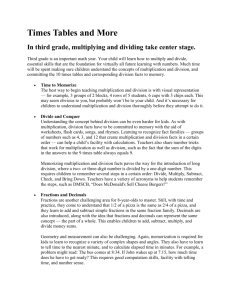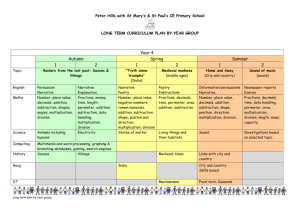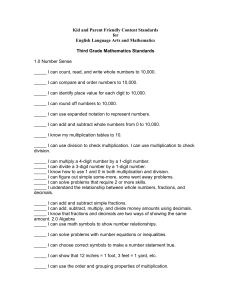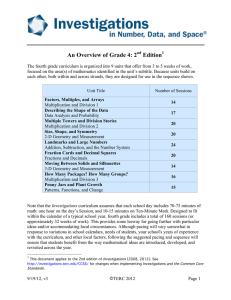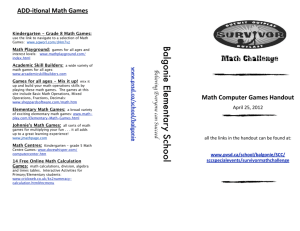THIRD GRADE MATH Goal The third grade mathematics program
advertisement
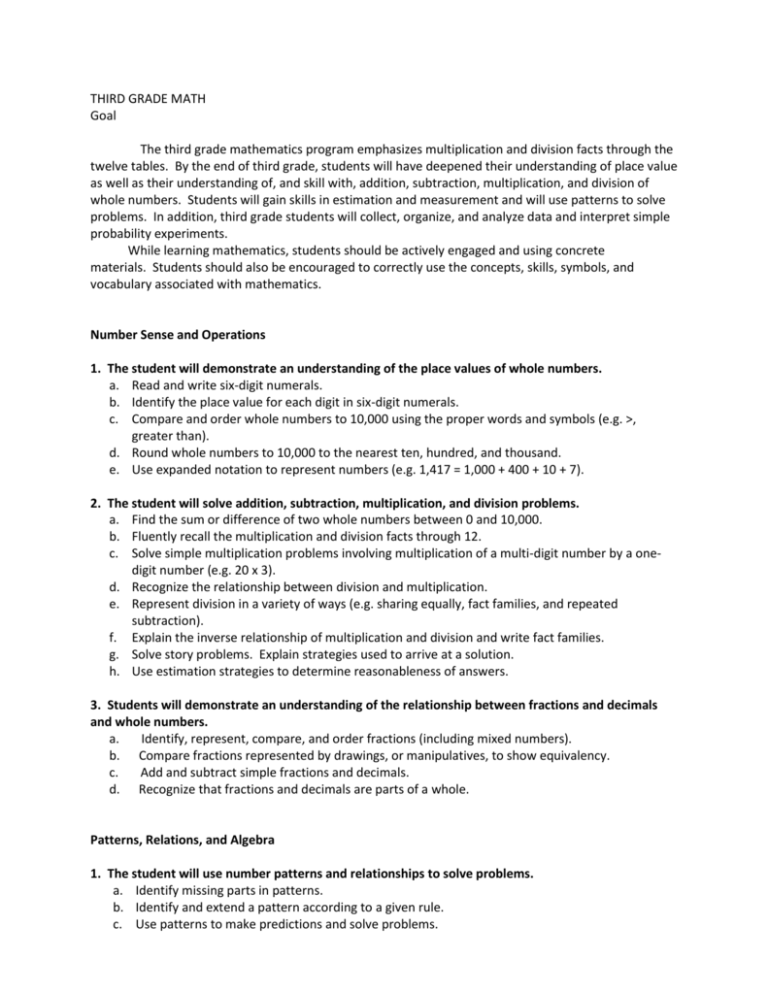
THIRD GRADE MATH Goal The third grade mathematics program emphasizes multiplication and division facts through the twelve tables. By the end of third grade, students will have deepened their understanding of place value as well as their understanding of, and skill with, addition, subtraction, multiplication, and division of whole numbers. Students will gain skills in estimation and measurement and will use patterns to solve problems. In addition, third grade students will collect, organize, and analyze data and interpret simple probability experiments. While learning mathematics, students should be actively engaged and using concrete materials. Students should also be encouraged to correctly use the concepts, skills, symbols, and vocabulary associated with mathematics. Number Sense and Operations 1. The student will demonstrate an understanding of the place values of whole numbers. a. Read and write six-digit numerals. b. Identify the place value for each digit in six-digit numerals. c. Compare and order whole numbers to 10,000 using the proper words and symbols (e.g. >, greater than). d. Round whole numbers to 10,000 to the nearest ten, hundred, and thousand. e. Use expanded notation to represent numbers (e.g. 1,417 = 1,000 + 400 + 10 + 7). 2. The student will solve addition, subtraction, multiplication, and division problems. a. Find the sum or difference of two whole numbers between 0 and 10,000. b. Fluently recall the multiplication and division facts through 12. c. Solve simple multiplication problems involving multiplication of a multi-digit number by a onedigit number (e.g. 20 x 3). d. Recognize the relationship between division and multiplication. e. Represent division in a variety of ways (e.g. sharing equally, fact families, and repeated subtraction). f. Explain the inverse relationship of multiplication and division and write fact families. g. Solve story problems. Explain strategies used to arrive at a solution. h. Use estimation strategies to determine reasonableness of answers. 3. Students will demonstrate an understanding of the relationship between fractions and decimals and whole numbers. a. Identify, represent, compare, and order fractions (including mixed numbers). b. Compare fractions represented by drawings, or manipulatives, to show equivalency. c. Add and subtract simple fractions and decimals. d. Recognize that fractions and decimals are parts of a whole. Patterns, Relations, and Algebra 1. The student will use number patterns and relationships to solve problems. a. Identify missing parts in patterns. b. Identify and extend a pattern according to a given rule. c. Use patterns to make predictions and solve problems. 2. The student will choose appropriate symbols, operations, and properties to solve simple number relationships. a. Solve problems involving numeric equations or inequalities. b. Solve a number sentence with a missing addend (e.g. 8 + n = 13). c. Select the operational symbol to make an expression true (e.g. 8 ? 5 = 13). Geometry 1. The student will identify, understand, and use basic geometric properties. a. Analyze and classify plane and solid geometric figures using relevant properties (e.g. number of corners, square corners, shape of faces and edges). b. Identify and draw representations of symmetry and congruence. c. Identify and draw representations of line segments and angles using a ruler or straight edge. d. Use geometric properties (length, width, and perimeter) of two-dimensional shapes to solve problems. e. Predict, illustrate, and verify which figures could result from a flip, slide, or turn of a given figure. Measurement 1. The student will select and use appropriate units and instruments for measurement. a. Estimate and measure: length (inches, feet, yards, centimeters, meters), weight (grams, ounces, pounds), and capacity (cups, pints, quarts, gallons, liters) using appropriate tools and units. b. Explore unit relationships within a system of measurement (e.g. four quarts = a gallon). c. Estimate and measure perimeter, area, and volume. d. Complete simple unit conversions within a system of measurement (e.g. nickels and dimes, centimeters and meters). 2. The student will measure quantities in real world applications. a. Count, compare, make change, and solve problems using a collection of coins and bills. b. Tell time to the nearest minute with digital and analog clocks. c. Read Celsius and Fahrenheit thermometers. d. Record temperatures. Data Analysis, Statistics, and Probability 1. The student will demonstrate an understanding of data collection, display, and interpretation. a. Collect, organize, and display data on line plots, bar or picture graphs, or charts. b. Identify different parts of a graph (e.g. title, labels, key). c. Read and interpret graphs and charts (e.g. bar, picture, circle, line) as sources of information. Draw conclusions and make predictions. 2. The student will use the concept of chance to explore the probability of actual events. a. Identify whether events are certain, likely, unlikely, or improbable. b. Record the possible outcomes for an event. c. Explore possible arrangements of a limited number of objects. d. Use the results of probability experiments to make predictions about future events.





